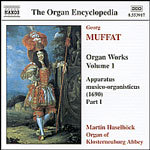
Organ Works, Vol. 1 (Apparatus musico-organisticus, Part I)
 $25.00
Out of Stock
$25.00
Out of Stock6+ weeks add to cart
GEORG MUFFAT
Organ Works, Vol. 1 (Apparatus musico-organisticus, Part I)
Martin Haselbock (organ)
[ Naxos Organ Encyclopedia / CD ]
Release Date: Sunday 5 June 2005
This item is currently out of stock. It may take 6 or more weeks to obtain from when you place your order as this is a specialist product.
Georg Muffat was born in Megève, Savoy, into a family of Scottish ancestry. As a boy he went to Alsace, then to Paris where he was proud to have studied with the great Lully from 1663 to 1669.
Thereafter he was a student of a Jesuit institution in Selestat, moving in 1671 to Molsheim, where he became organist of the exiled Strasbourg Cathedral chapter. Danger of war took him to Ingolstadt, and later in a flight "to Vienna in Austria, Prague and then finally to Salzburg and Passau". During a period as organist and chamber musician to the Archbishop of Salzburg he was granted extended leave to go to Italy, where from 1680 to 1682 he studied with Pasquini and wrote Concertos that were performed in Corelli's house. In 1690 he left Salzburg and moved to Passau, where he remained as a Kapellmeister to the Court of the Bishop and tutor to the Court pages.
Muffat, Who always considered himself a German, was the first truly international Composer who could combine in his art the extremes of the French and Italian styles. The new "mixed style" was later described by Quantz as a way "to choose the best from the styles of different countries".
Muffat himself saw this new synthesis not only as an artistic aim but also as a political goal, as he declared in a dedication to the Prince-Bishop of Passau: "The notes, the pages, the sweet musical notes give me my daily work, and as I mix the French style with the German and Italian, I do not stir up any conflict, but rather perhaps give a foretaste of the desired harmony among the people, for beloved peace." In another dedication he writes about "the chance to see Italy, where I applied myself to learning to temper the profound Italian emotions with the French festivity and sweetness, so that neither could become too darkly pathetic nor too light-heartedly free."
The Apparatus musico-organisticus was published in Salzburg in 1690 and is Muffat's second published work after the Armonico tributo of 1682. The Composer was able to present the work to it, dedicatee, the Emperor Leopold I, in Augsburg during the Coronation of Leopold's Son Joseph as Roman king. An engraving was therefore added to the first page of music showing a Turk lying on the ground under the feet of a Christian, with the Turkish army in flight in the background, presumably an allusion to the defeat of the Turks after the siege of Vienna in 1683 and 1684. The work is the largest published collection of major organ pieces of the period and enjoyed some popularity, being re-issued in Vienna between 1704 and 1726. In a Latin foreword, translated into German in the later edition, the composer describes the content as "twelve Musical Pieces or long Toccatas (as one says)/delicately arranged in a new way for the particular delight of Music-lovers/and for ample exercise in this art. To which are added/ a Ciacona, a Passacaglia, then also a well-harmonized Cyclopeias, each of which is distinguished by many variations".
Muffat's collection can be considered the third major collection of organ music by a composer in the Habsburg Empire after the Libri by the Austrian Court Organists Johann Jakob Froberger and Johann Kaspar Kerll. These Italian style Libri combined Short Toccatas with Canzonas, Ricercari, Variations and free pieces in the principal church modes. In contrast to Short versetti used in alternation with choral or Gregorian chants verses, the longer pieces were used as Preludes and Postludes or for more extended parts of the liturgy, such as the post elevationem, after the consecration.
Muffat's "long Toccatas" combine in their multiple sections the free writing of the old Toccata with the polyphony of canzonas and other fugal forms. Muffat's pedagogical purpose in the Apparatus, which he dedicated to the "particular delight of music lovers and for ample exercise in this art" can be felt throughout the work, in the use of the principal church modes in Toccatas I to VIII, in the multiple formal structures, in the use of Italian stylistic elements and even in the sometimes unusual form of notation, using all nine clefs and some archaic forms of ornamentation in Toccata XI.>
With their use of consecutive church tones the first eight Toccatas can be performed on a mean-tone instrument, therefore the famous organ of Kloster-neuburg Abbey was chosen for this recording. The second part of the Apparatus with its more modem features could not be played on this archaic organ.
Tracks:
01. Toccata prima 05:08
02. Toccata secunda 05:38
03. Toccata tertia 05:36
04. Toccata quarta 07:17
05. Toccata quinta 05:26
06. Toccata sexta 09:24
07. Toccata septima 09:21
08. Toccata octava 06:39
